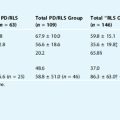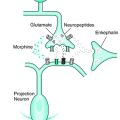Chapter 36 Management of Restless Legs Syndrome in the Hospital and During Surgery
Restless legs syndrome (RLS) is a quiescegenic disorder; its symptoms emerge at rest. Therefore, a critical worsening of RLS during hospital stays, which include bedrest, is common.
Pathophysiologic Aspects of Perioperative Restless Legs Syndrome
The emergence of symptoms at rest is one of the essential symptoms of RLS,1 and immobilization is used to provoke RLS symptoms and derived periodic limb movements (PLM) in the suggested immobilization test.2 From this context, it becomes clear that bedrest during hospital stays and, even more so, immobilization of the legs (possibly also other parts of the body) can trigger RLS symptoms in mild cases or contribute to a critical worsening in more severely affected patients. Intraoperative and postoperative blood loss reduces body iron stores and represents an additional contributing factor (see Chapter 9 for the role of iron metabolism and anemia in RLS).
Both RLS and PLM have been observed during epidural and spinal anesthesia, with symptoms occurring either during anesthesia or as the effect is wearing off. Shin³ pointed out that severe restlessness may occur during epidural anesthesia in patients with RLS. He describes a 30-year old woman with RLS since childhood, which worsened during pregnancy, who had a cesarean section with epidural anesthesia. The patient experienced an urge to move the legs but was unable to do so due to the motor block and violently thrashed her head and arms. Symptoms improved with diazepam.3 Ward4 describes his own experience of an RLS-like syndrome during epidural anesthesia. While the motor block was active and the effect of anesthetic was wearing off, he suffered from a severe urge to move the legs; symptoms were later alleviated by walking around. Although Ward used the term “akathisia” in this case report, the similarity with RLS is evident. Because a previous surgery in spinal anesthesia with carbocaine and epinephrine was uneventful, the author, who is a psychiatrist, attributed his symptoms to the effect of droperidol, which was administered together with metoclopramide in the preoperative phase.4
Periodic limb movements during wakefulness (PLMW) were observed in a patient without any history of RLS or PLM during epidural and spinal anesthesia, during the phase of motor paralysis.5 The same authors had reported PLM during wakefulness in another patient during spinal anesthesia, in whom PLM during sleep had also been documented. It was not stated whether this patient also had RLS.6 Watanabe and colleagues5 used the term “anesthesia-related PLM” (AR-PLM) to characterize these phenomena. They suggested that AR-PLM and PLM during sleep may share a common etiology with spinal anesthesia or sleep-related suppression of descending inhibitory spinal pathways or corticospinal tract dysfunction.5
Several other case reports deal with myoclonus-like and other involuntary movements in patients undergoing surgery during spinal or epidural anesthesia, or in the immediate postoperative phase.7–12 In some of them, it is controversial whether the movements resembled PLM or spinal or propriospinal myoclonus. A prospective study found that transient RLS occurred in 8.7% of 202 patients undergoing spinal anesthesia for orthopedic and other surgery.13
An imbalance in sensorimotor integration13 may underlie the occurrence of RLS and PLM during spinal anesthesia, specifically during its wearing off. Another suggested mechanism is reduced blood flow in the lower extremities or spinal cord.14 The use of epinephrine in spinal anesthesia prolongs duration of effect15 but may reduce blood flow to spinal cord.16
New onset of RLS independent of type of anesthesia has also been reported in patients undergoing surgery for other reasons. For example, familial RLS first manifested itself after heart surgery in a 9-year-old boy17—in this case, the interaction compromised brain iron regulation and blood loss was discussed. A recent survey focused on patients undergoing lung transplant and reported an extremely high frequency of 47.2%. The authors discuss that the increased incidence of steroid-induced diabetes, drug-induced anemia, renal dysfunction, and neuropathy might all contribute to an increased risk for RLS in this specific surgical population.18
Treatment
General Principles
1. Monitoring Iron Status
Continuous monitoring of iron status is critical in all patients with RLS undergoing surgery or hospital stays for other reasons. Replenishing body iron stores improves baseline conditions for RLS treatment. In patients with severe RLS and anemia, blood transfusions may be indicated to treat the RLS. Dramatic improvement after blood transfusions of severe iron-deficient RLS apparently refractory to treatment have been reported.19 Parenteral iron substitution is indicated for rapid correction of iron deficiency. Iron status should be checked in RLS patients even before minor surgery and iron replacement initiated if body iron stores are found to be low (refer to Chapter 34).
2. Ensure Continuous Drug Delivery
In the immediate perioperative phase, oral medications often have to be discontinued. Because continuous and efficient RLS treatment is critical in this phase, nonoral drug delivery has to be established when oral medication is withheld for a prolonged period of time. Baseline RLS treatment should be continued as long as possible before surgery. One should remember that re-emergence of RLS symptoms after temporarily stopping oral medication greatly varies due to variable plasma half-life of the medication, from 2 to 4 hours with levodopa20 to 65 hours with cabergoline.21
Systemic Dopaminergic Treatment
Recent studies have shown that transdermal delivery of dopaminergic drugs like rotigotine patch22 or lisuride patch23 is efficacious in RLS. Patch applications may provide a useful treatment mode for patients in the fasting state. Although stable plasma levels can be reached, and patch treatment is expected to provide a good baseline treatment, it remains to be established if the onset of action is fast enough to realize shorthand adaptations to increasing dose needs in inpatients. Rotigotine has already been approved for Parkinson’s disease.
Intravenous levodopa infusions have been used in Parkinson’s disease patients with motor fluctuations.24 Although long-term treatment with intravenous levodopa is classified as undesirable, short-term application has proved to be feasible.24 Phlebitis at the application site and tolerance after infusions lasting only 21 hours have been observed.25 In RLS patients, data on intravenous application of levodopa are not available. Several caveats and interactions relevant to this chapter are mentioned in the drug information for levodopa. The inhalant agent halothane may precipitate cardiac arrhythmia in patients treated with madopar. It should be noted that opioid administration may reduce the efficacy of levodopa. Administration of iron II sulfate reduces the maximal plasma concentration of L– dopa and the area under the curve by 30% to 50%, respectively (see drug information for L-dopa).
Apomorphine can be delivered via both intravenous and subcutaneous routes. The usefulness of nocturnal subcutanous apomorphine infusion was first demonstrated in two patients with RLS who received apomorphine delivered over a 12-hour nighttime period.26 In another study, a single dose of 0.5 mg apomorphine subcutaneously was used at bedtime in nine patients with RLS. A significant reduction of the PLMS was found but lasted only 4 hours after injection.27 Subjective symptoms are not reported.27 Tribl and coworkers28 treated nine patients with very severe RLS with intravenous apomorphine. Both subjective (RLS severity visual analogue scale) and objective (PLM in suggested immobilization test) outcome variables were significantly improved. The rapid onset of action was also emphasized. Despite 3 days of pretreatment with domperidone, side effects were frequent and consisted of drowsiness, yawning, and falling asleep.28
Intravenous and subcutaneous use is also described for the dopamine agonist lisuride in patients with Parkinson’s disease.29,30 However, lisuride is not available in all countries. Amantadine has been shown to improve RLS,31,32 and it is available for an endovenous application. Its usefulness in peripoperative patients has not been investigated.
Because dopamine agonists tend to disrupt sleep,27,33,34 an additional nighttime hypnotic may be warranted in some patients.
Opiates
The efficacy and role of opioids in the treatment of RLS are discussed in Chapter 32 and elsewhere.35 Opiate analgesics are part of many postoperative pain treatment regimens. Systemic delivery is well established and includes intravenous, intramuscular, subcutaneous, and transdermal applications. In the immediate perioperative and postoperative phases, as well as in chronic pain conditions, continuous regional or epidural applications are also performed. Substances that have been used in RLS36 include propoxyphene (130 to 520 mg/day), codeine (15 to 120 mg/day), oxycodone (2.5 to 20 mg/day), hydrocodone (5 to 15 mg/day), pentazocine (50 to 200 mg/day), and tramadol (50 to 150 mg/day) (short half-life agents) and methadone (5 to 30 mg/day), levorphanol, and SR morphine (as long half-life agents).36
In the immediate postoperative phase, opiates can also be administered epidurally, if the catheter remains in situ after surgery.37 Transdermal opiates are also available, such as fentanyl or buprenorphine. However, in pain treatment, transdermal delivery is mainly used to maintain baseline treatment, and intravenous application is preferred, if rapid onset of action is required. RLS patients who have received opioids for more than a few days should be carefully tapered off the medication, because both restlessness and symptoms of RLS can emerge or worsen during abrupt withdrawal from long-term opiates38 or during rapid detoxification in opiate-dependent patients.39 Transient RLS symptoms during opiate withdrawal emerged in 15 of 120 opiate addicts in a retrospective study.40 Development of sleep apnea needs to be monitored in RLS patients receiving opiates.41
Antiepileptics
Valproic acid (VPA) is available in an intravenous preparation, facilitating both nonoral delivery and rapid saturation. A recent study has shown that VPA is a good treatment alternative for RLS and PLM when dopaminergic drugs cannot be used or are ineffective.42 For treatment of RLS, doses around 600 mg/day are used. Clonazepam is also used as a co-treatment for RLS.
Treatment of Complications
In patients with the most severe form of RLS, a combination treatment with opiates, dopaminergic agent and benzodiazepine, or VPA may be required. One possible specific complication of surgery in RLS patients is persistent PLMS during epidural anesthesia (see earlier case reports). If this occurs, opiates (e.g., epidural morphine) should be applied.37
3. Increase Dosage if Needed
Even if blood loss is insignificant, and disruption of oral medication intake irrelevant, bedrest, immobilization, pain, and sleep deprivation may contribute to the temporary aggravation of RLS. If this occurs, treatment has to be increased above the usual dose during the perioperative phase during hospital stay. In case of acute exacerbation of symptoms, an additional dose of a systemic opiate may rapidly provide relief. Ancillary measures may also be tried, but it has not been investigated whether physical therapy (e.g., exercises, massages, cold/hot application), automatic dynamic/active splints, or pulsatile air bed systems can contribute to alleviation of RLS symptoms in perioperative patients.
4. Avoid Potentially Harmful Drugs
Typical neuroleptics have the potential to induce or worsen RLS and should be avoided in the anesthesia or as antiemetics in RLS patients. This is true both for neuroleptics used in combined anesthesia (e.g., droperidol) and for antiemetics (e.g., metoclopramide, promethazine, prochlorperazine). Ondansetron, a selective serotonin3 receptor antagonist, is effective in the treatment of postoperative nausea and vomiting.43 Scarce studies from the early 1980s report a benefit for intravenous domperidone,44,45 but domperidone is currently used only as an oral preparation in many countries and is not available in others. Beyond the context of surgery, many other medications have been reported to induce or worsen RLS. It might be wise not to initiate these medications in the immediate postoperative phase, but there is no need to discontinue long-term treatment if there is no temporal relation with worsening of RLS.
Conclusion
Specific, skillful, and sufficient management of RLS is critical in patients during hospital stays and surgery. Specifically designed information brochures, such as the brochure “Surgery and RLS” from the Restless Legs Syndrome Foundation (www.rls.org) provide valuable help.
1. Allen RP, Picchietti D, Hening WA, et al. Restless legs syndrome: Diagnostic criteria, special considerations, and epidemiology. A report from the restless legs syndrome diagnosis and epidemiology workshop at the National Institutes of Health. Sleep Med. 2003;4:101-119.
2. Montplaisir J, Boucher S, Nicolas A, et al. Immobilization test and periodic leg movements in sleep for the diagnosis of restless legs syndrome. Mov Disord. 1998;13:324-329.
3. Shin YK. Restless legs syndrome: Unusual cause of agitation under anesthesia. South Med J. 1987;80:278-279.
4. Ward NG. Akathisia associated with droperidol during epidural anesthesia. Anesthesiology. 1989;71:786-787.
5. Watanabe S, Ono A, Naito H. Periodic leg movements during either epidural or spinal anesthesia in an elderly man without sleep-related (nocturnal) myoclonus. Sleep. 1990;13:262-266.
6. Watanabe S, Sakai K, Ono Y, et al. Alternating periodic leg movement induced by spinal anesthesia in an elderly male. Anesth Analg. 1987;66:1031-1032.
7. Lee MS, Lyoo Ch, Kim WC, et al. Periodic bursts of rhythmic dyskinesia associated with spinal anesthesia. Mov Disord. 1997;12:816-817.
8. Nadkarni AV, Tondare AS. Localized clonic convulsions after spinal anesthesia with lidocaine and epinephrine. Anesth Analg. 1982;61:945-947.
9. Moorthy SS, Dierdorf SF. Restless legs during recovery from spinal anesthesia. Anesth Analg. 1990;70:337.
10. Fox EJ, Villanueva R, Schutta HS. Myoclonus following spinal anesthesia. Neurology. 1979;29:379-380.
11. Martinez LP, Koza M. Anesthesia-related periodic involuntary movement in an obstetrical patient for cesarean section under epidural anesthesia: A case report. AANA J. 1997;65:150-153.
12. Parkinson SK, Bailey SL, Little WL, et al. Myoclonic seizure activity with chronic high-dose spinal opioid administration. Anesthesiology. 1990;72:743-745.
13. Högl B, Frauscher B, Seppi K, et al. Transient restless legs syndrome after spinal anesthesia—A prospective study. Neurology. 2002;59:1705-1707.
14. Ancoli-Israel S, Seifert AR, Lemon M. Thermal biofeedback and periodic movements in sleep: Patients’ subjective reports and a case study. Biofeedback Self Regul. 1986;11:177-188.
15. Chambers WA, Littlewood DG, Logan MR, et al. Effect of added epinephrine on spinal anesthesia with lidocaine. Anesth Analg. 1981;60:417-420.
16. Kane RE. Neurologic deficits following epidural or spinal anesthesia. Anesth Analg. 1981;60:150-161.
17. Cortese S, Konofal E, Lecendreux M, et al. Restless legs syndrome triggered by heart surgery. Pediatr Neurol. 2006;35:223-226.
18. Minai OA, Golish JA, Yataco JC, et al. Restless legs syndrome in lung transplant recipients. J Heart Lung Transplant. 2007;26:24-29.
19. Brandauer E, Frauscher B, Saletu M, et al. Complete remission of severe restless legs syndrome after relief of iron deficiency. J Sleep Res. 2002;11(supp. 1):24.
20. Nutt JG, Woodward WR. Levodopa pharmacokinetics and pharmacodynamics in fluctuating parkinsonian patients. Neurology. 1986;36:739-744.
21. Lera G, Vaamonde J, Rodriguez M, Ondo JA. Cabergoline in Parkinson’s disease: Long-term follow up. Neurology. 1993;43:2587-2590.
22. Stiasny-Kolster K, Kohen R, Schollmayer E, et al. Patch application of the dopamine agonist rotigotine to patients with moderate to advanced stages of restless legs syndrome: A double-blind, placebo-controlled pilot study. Mov Disord. 2004;19:1432-1438.
23. Benes H. Transdermal lisuride: Short-term efficacy and tolerability study in patients with severe restless legs syndrome. Sleep Med. 2006;7:31-35.
24. Nyholm D, Aquilonius SM. Levodopa infusion therapy in Parkinson disease: State of the art in 2004. Clin Neuropharmacol. 2004;27:245-256.
25. Nutt JG, Carter JH, Woodward W, et al. Does tolerance develop to levodopa? Comparison of 2- and 21-H levodopa infusions. Mov Disord. 1993;8:139-143.
26. Reuter I, Ellis CM, Chaudhuri KR. Nocturnal subcutaneous apomorphine infusion in Parkinson’s disease and restless legs syndrome. Acta Neurol Scand. 1999;100:163-167.
27. Haba-Rubio J, Staner L, Cornette F, et al. Acute low single dose of apomorphine reduces periodic limb movements but has no significant effect on sleep arousals: A preliminary report. Neurophysiol Clin. 2003;33:180-184.
28. Tribl GG, Sycha T, Kotzailias N, et al. Apomorphine in idiopathic restless legs syndrome: an exploratory study. J Neurol Neurosurg Psychiatry. 2005;76:181-185.
29. Obeso JA, Luquin MR, Martinez Lage JM. Intravenous lisuride corrects oscillations of motor performance in Parkinson’s disease. Ann Neurol. 1986;19:31-35.
30. Luquin MR, Obeso JA, Martinez-Lage JM, et al. Parenteral administration of lisuride in Parkinson’s disease. Adv Neurol. 1986;45:561-568.
31. Evidente VG, Adler CH, Caviness JN, et al. Amantadine is beneficial in restless legs syndrome. Mov Disord. 2000;15:324-327.
32. Hening W, Allen RP, Earley CJ, et al. An update on the dopaminergic treatment of restless legs syndrome and periodic limb movement disorder. Sleep. 2004;27:560-583.
33. Högl B, Rothdach A, Wetter TC, et al. The effect of cabergoline on sleep, periodic leg movements in sleep, and early morning motor function in patients with Parkinson’s disease. Neurophysiology. 2003;28:1866-1870.
34. Happe S, Sauter C, Klösch G, et al. Gabapentin versus ropinirole in the treatment of idiopathic restless legs syndrome. Neuropsychobiology. 2003;48:82-86.
35. Lesage S, Hening WA. The restless legs syndrome and periodic limb movement disorder: a review of management. Semin Neurol. 2004;24:249-259.
36. Hening W, Allen RP, Walters AS, et al. Motor Functions and Dysfunctions of Sleep. Sleep Disorders Medicine. Basic Science, Technical Considerations, and Clinical Aspects. London: Butterworth-Heinemann, 1999;441-508.
37. Trenkwalder C, Jakob W. Restless Legs Syndrome—Leitfaden für Anästhesisten. München, 2008, Max Planck Institut für Psychiatrie München.
38. Freye E, Levy J. Acute abstinence syndrome following abrupt cessation of long-term use of tramadol (Ultram): A case study. Eur J Pain. 2000;4:307-311.
39. Freye E, Levy JV, Partecke L. Use of gabapentin for attenuation of symptoms following rapid opiate detoxification (ROD)—Correlation with neurophysiological parameters. Neurophysiol Clin. 2004;34:81-89.
40. Scherbaum N, Stuper B, Bonnet U, et al. Transient restless legs-like syndrome as a complication of opiate withrawal. Pharmacopsychiatry. 2003;36:70-72.
41. Walters AS, Winkelmann J, Trenkwalder C, et al. Long-term follow-up on restless legs syndrome patients treated with opioids. Mov Disord. 2001;16:1105-1109.
42. Eisensehr I, Ehrenberg BL, Rogge Solti S, et al. Treatment of idiopathic restless legs syndrome (RLS) with slow-release valproic acid compared with slow-release levodopa/benserazid. J Neurol. 2004;251:579-583.
43. Gan TJ. Selective Serotonin 5-HT3 receptor antagonists for postoperative nausea and vomiting: Are they all the same? CNS Drugs. 2005;19:225-238.
44. Boghaert A, Carron D, Gallant J, et al. Postoperative vomiting treated with domperidone. A double-blind comparison with metoclopramide and a placebo. Acta Anaesthesiol Belg. 1980;31:129-137.
45. van Leeuwen L, Helmers JH. The efficacy of domperidone (R33812) in the treatment of postoperative vomiting. A double-blind study with a placebo. Anaesthesist. 1980;29:490-493.





